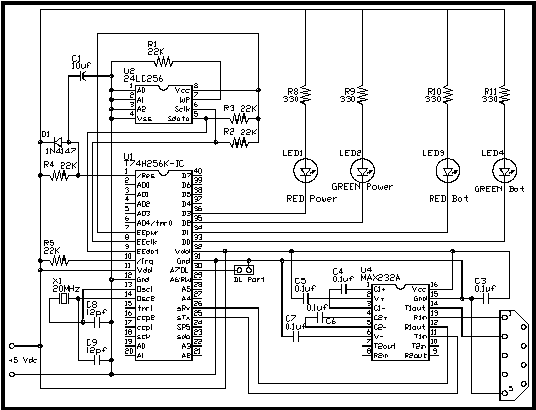|

|
Microcontroller
Technology Development & Sales
11170 Flatiron Drive
Lafayette, Colorado 80026 USA
sales@protean-logic.com
http://www.protean-logic.com
Phone: 303-828-9156 Fax: 303-828-9316
|
TICkit
74 Interpreter IC
(Part
Number: T74H256J-IC)

Overview
Protean
Logic’s TICkit 74 Interpreter IC is the core of the TICkit 74 product line.
It is available as a 40 pin DIP (0.6” row centers) or special ordered
as a surface mount 44 pin PLCC.
To
create a working TICkit microcontroller, a reset circuit, a serial EEPROM, a
crystal, and some passive components are required in addition to the TICkit
interpreter IC. Use of the TICkit
IC in your project offers cost savings, layout flexibility, miniaturization, and
design options above those available when using a module or SBC. During the
design and prototyping phase of a project ,
proof of concept and rapid development are primary goals which suggest
the use of pre-assembled modules, single board computers or laboratories. When
projects are in production, however, miniaturization, durability, and low
component count and cost are primary goals which suggest the use of the
interpreter IC in a custom TICkit circuit.
The
schematic above shows a typical TICkit 74 circuit which requires only a 24LC256
EEprom, a crystal, 5 resistors, 1 diode, and three capacitors. This circuit adds
an RS232 buffer and some LEDs to form a simple RS232 monitor. Notice that the
TICkit processor has sufficient I/O drive to light multiple LEDs without
external drivers.
Features
- IBM
PCAT keyboard interface: Applications; use a PCAT keyboard, scanner etc. for
input.
- Audio
playback from EEprom: Applications; sound effects, spoken output, complex
waveform generation.
- 4-voice
sine wave generator: Applications; DTMF output (phone dialing). music output
(4 line chorus).
- Background
real time clock: Applications; DAQ time standard, periodic functions, time
of day/calendar, clocks.
- Time
base interrupts: Applications; background processing, time-out processing.
- Real-time
functions (2 marks): Applications; measure elapsed time precisely, sample
waveforms in real-time.
- Dallas
one-wire support: Applications; interface Dallas temperature sensors,
security keys or multidrop sensors.
- X-10
Power line carrier transmission: Applications; automate lighting, control
HVAC equipment, PIR security system, control other commercially available
X-10 devices.
- X-10
Power line carrier reception: Applications; monitor X-10 messages, use X-10
feedback.
- Simultaneous
pulse generation for 4 RC servos: Applications; RC servos for robotic
actuators, model airplanes, satellite RC servo controller. Control up to 16
servos with single TICkit.
- 2
background PWM generators: Applications; control motors in background, use
as 10-bit D to A converters.
- SPI
/ 3-wire interface (in background): Applications; interface to devices like
LTC1298 A/D or 74LS594 ICs.
- I2C hardware slave (in background):
Applications; create an I2C based network.
- I2C master generation: Applications;
control I2C devices like 24LC EEproms or Protean’s Xtender IC.
- Up
to 256K bytes of EEprom storage: Applications; store audio samples,
non-volatile data storage, use for POS transaction storage, use for long
term DAQ, bank select for even larger amounts of EEprom.
- 32K
byte program size: Applications; create programs 50,000 lines long!
Subroutine calls limited only by RAM.
- 128
Bytes of RAM: Applications; variables storage, subroutine calls. Efficient
use supports huge programs.
- RS232
hardware (in background): Applications; implement high baud rates; Implement
9 bit formats, Implement interrupt driven ring buffers.
- RS232
emulation routines (foreground): Applications; up to 19200 baud with no RTC
time loss, full handshaking scheme. RS_SCANF function parses input fields.
Supports inverted or true levels. Custom baud rates allowed.
- 8
bit counter/timer with 8 bit prescaler: Applications; count pulses in
background, monitor RPM or frequency.
- 16
bit counter/timer (in background, not available when using RTC):
Applications; count pulses in background, RPM monitoring, frequency
measurement, interval measurement, count capturing. (Use with CCP).
- Rotary
encoder support (foreground): Applications; update counts on up to 2
switches, use for “wheel” input devices or slow speed position sensing,
create closed loop servo systems.
- 3
types of RC resistance or capacitance measurement functions: Applications;
Use with pull up/down for delay measure, use potentiometers as input
devices.
- 32
bit floating point math: Applications; mathematic operations like PID
calculations, scientific calculations.
- 32
bit signed integers: Applications; monetary calculations, fixed-point
support, high precision A/D.
- 8/16
bit unsigned integers: Applications; normal process calculations.
- String
operations: Applications; easily support for text, user interface or text
based games.
- 4/8
bit parallel bus functions: Applications; interface peripheral ICs, 4 bit
devices, octal latches and multiplexers, or common LCD modules.
- Various
pulse gen and measurement: Applications; instruments, determine RPM using
period measurement.
- Digital
I/O on 26 pins: Applications; I/O intensive applications, control LEDs,
small motors and relays, monitor switches, optical sensors, analog
comparators and digital inputs.
- 8
bit A/D conversion available on 2 I/O pins: Voltage measurement, analog
measurement.
- Modern
FBasic programming language: Applications; easily update and modify FBasic
programs in Win95/98/2000/NT Integrated environment. Supports data
structures and arrays. Functions and libraries allow encapsulation.
Parameter passing and local variables. Structured flow control. Programs can
be freely distributed.
- Fast
token based interpreter: Applications; Programs run relatively fast. Token
code is not easily un-assembled. Interpreter ICs can be purchased separately
for embedding.
|


